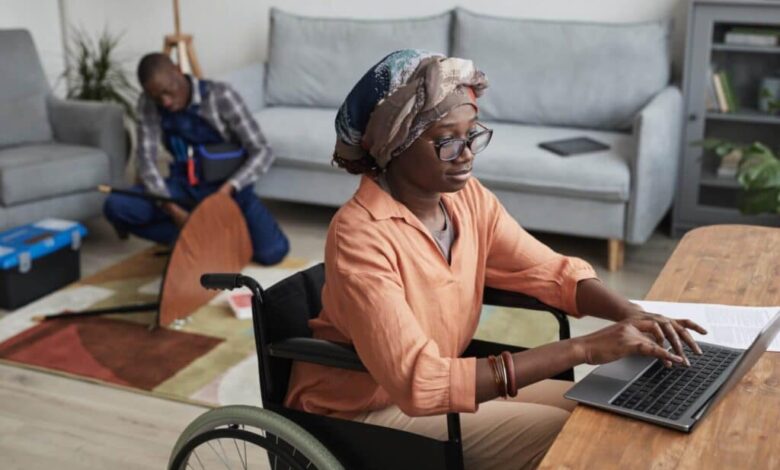Will Women with Disabilities Lose Opportunities as the Remote Work Revolution Loses Steam? – Women’s eNews


Last August, the number of employed women hit a new high: 77.7 percent age 25 to 54 were paid workers. Researchers attribute the surge to a variety of factors but agree about the major reason: remote work. And while remote work has been a boon to working women in general, for those with disabilities, it has been a (sometimes literal) lifeline.
People with disabilities have always been at a disadvantage when it comes to employment. The labor force participation rate for people with disabilities is 24.5 percent as opposed to 67.6 percent for people without disabilities. Now the good news: 24.5 percent is an all-time high employment rate for people with disabilities. Additionally, women with disabilities, who typically lag behind men with disabilities, enjoyed a bigger bump in employment than their male counterparts.
Telework seems to be the great leveler, which may explain the reason behind the decrease in the gender gap, as women with disabilities are more likely to telework than men with disabilities. Why? It could be that they choose telework to help with family-work-life balance (women with disabilities now become mothers at the same rate as those without). It could be that the most common secondary condition reported by women with physical disabilities is fatigue, which is easily alleviated by remote work. Or it could be that more women with disabilities are forced to work, as they are 20 percent more likely to be wrongly rejected for Social Security benefits than men with the same disabilities.
Barrier Removal: It’s Not Just About Ramps
Regardless of the reasons, remote work removes multiple barriers for working women with disabilities. For example, Susan Mazrui, the director of Global Public Policy at AT&T Services, Inc., who is blind and lives with multiple sclerosis, began telecommuting while undergoing cancer treatment prior to the Covid pandemic. “It was just safer,” she recalls. “If I had to go into an office, it would have been too high risk.” She continues to telecommute so she can better focus on her work. “I don’t use my energy to commute back and forth,” she says, noting that her commute would take several buses each way. “I figured out that my closest office would be two hours and fifteen minutes each way by public transportation. By the time I got to work, I’d be exhausted.”
Anastasia Somoza, a disability rights advocate, speaker and consultant, and full-time wheelchair-user, faces a different challenge when it comes to commuting: subway elevators—or rather, out-of-order subway elevators. When Anastasia was offered a position with the New York City Council in 2018, she accepted the job with the caveat that she could work remotely whenever the subway elevators were not working. Remote work also removes another barrier for Anastasia. “I require direct personal care support for my activities of daily living,” she says, “which means that if the support staff who gets me out of bed in the morning cannot do that in an emergency, I need to have the ability to work from home.”
Yet there’s another, less obvious barrier that telework removes for women with disabilities. “I no longer have to deal with condescension, or engage in discussions with HR regarding the necessity of accommodations,“ says Sarah Sharp, a clinical recruiter for the healthcare industry. Often, “Incredibly ignorant, infuriating, and hurtful comments were commonplace among coworkers (including, “What did your mom do while she was pregnant for you to deserve this?”), Sarah continues. “It made me feel as though I had to work twice as hard to be valued and recognized for my contributions.”
Yet there’s even a more subtle barrier. “If I walk into a room, my disability is the first thing people notice. I’d like to say it’s my stunning beauty, but it’s not,” she adds. “AT&T has worked to be a really welcoming environment for people with disabilities. But not every company or organization I deal with has that same benefit, so people may feel awkward. I have to spend time getting them comfortable rather than just focusing on the issue at hand. In the high-tech, very fast-paced business world today, that can detract from my ability to communicate on business issues.”
Sarah and Susan aren’t alone when it comes to societal barriers in the workplace. According to McKinsey and Company’s 2023 Women in the Workplace report, women with traditionally marginalized identities face more microaggressions at work, and women with disabilities face the most, even more than LGBTQ+ individuals and women of color. Fortunately, remote work removes some of those microaggressions. Since Sarah requires minimal disability-specific accommodations when teleworking, “It allows me the option to navigate under the radar as a person with a disability if I prefer,” she continues.
Why Are These Opportunities Shrinking?
One reason may be the empathy gap (an in-group bias) that allows executives to ignore its benefits for women with disabilities. It could also be an omission bias that makes them believe that not supporting people with disabilities isn’t important. Or, it could just be that they’d like to get back to “business as usual.” Whatever the reason, remote work is being phased out.
This past September, remote job postings on LinkedIn had declined to less than half the share of jobs listed as remote in early 2022. Further, a number of federal government agencies are now requiring employees to return to the office, and 64 percent of global executives believe the world will return to full in-office work by 2026, according to the KPMG Global CEO Outlook.
What does this mean for women with disabilities who need to work remotely? That depends. Telework can be considered a reasonable accommodation under the American with Disabilities Act. “Reasonable accommodation is a leveling of the playing field,” says Robin Jones, the director of the Great Lakes ADA Center. “It’s not ever lowering the standards or exempting people from job tasks and activities. It’s providing tools that enable them to do the work by modifying either a policy, practice, or procedure. Every accommodation is case by case,” Robin continues, “It’s not cookie cutter.”
Anastasia, Sarah, and Susan consider remote work to be a reasonable accommodation for their jobs. “It allows me to perform the essential functions of my job,” Susan says. “Accommodations do not in any way harm my performance. They actually enhance it.” But it also benefits her employer: Since her remote work system was set up prior to COVID, AT&T already had security and privacy systems in place, making it easier to accommodate other employees who needed to work from home during the pandemic. Susan views this as proof that employers should continue to provide opportunities—including remote work—for women with disabilities. “There are always going be situations where you’re going to have to pivot,” she says. “You’re going to have to be flexible and resilient. And I can’t think of a population that’s more flexible and resilient.”





